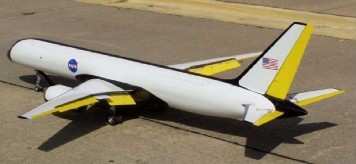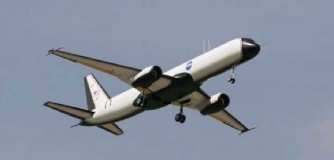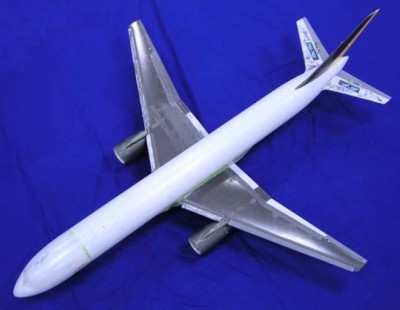Adapts To Changing Aircraft Conditions, Implications For
Hypersonic Flight
 An L1 adaptive flight control system flew on a NASA GTM
aircraft (T2) on March 24, during the last deployment of the
AirSTAR team at Fort Pickett, VA. The flight, number 14 for
the aircraft, lasted approximately 16 minutes, with the adaptive
controller closing the inner-loop for about 14 minutes.
An L1 adaptive flight control system flew on a NASA GTM
aircraft (T2) on March 24, during the last deployment of the
AirSTAR team at Fort Pickett, VA. The flight, number 14 for
the aircraft, lasted approximately 16 minutes, with the adaptive
controller closing the inner-loop for about 14 minutes.
The first successful flight of the L1 adaptive controller on NASA's
GTM is the result of work by Professor Naira Hovakimyan and PhD
student Enric Xargay at the University of Illinois at
Urbana-Champaign, and Professor Chengyu Cao, currently at
University of Connecticut. The development of this theory started
five years ago, when Hovakimyan and Cao were affiliated with
Virginia Tech. The L1 adaptive control architecture implemented
onboard is an all-adaptive control law, thus providing both nominal
performance and mitigating performance degradation due to faults
and failures.
"The architectures of L1 adaptive control theory have guaranteed
transient performance and guaranteed robustness in the presence of
fast adaptation, without enforcing persistence of excitation,
without any gain scheduling in the controller parameters, and
without resorting to high-gain feedback," explained Hovakimyan, who
is a Schaller Faculty Scholar and professor of mechanical science
and engineering at Illinois. Moreover, the current L1 architecture
accommodates uncertainty that is not directly controllable
(unmatched) and cannot be addressed by recursive design methods,
like backstepping.

NAS Adaptive Control Test Aircraft
"It was the first flight of a direct
all-adaptive controller with a pilot in the loop," according to Dr.
Irene Gregory, the project's point-of-contact at NASA. The T2 is a
twin-engine jet-powered and dynamically-scaled (5.5%) civil
transport aircraft, designed and instrumented to perform control
law evaluation, experiment design and modeling research, in-flight
failure emulation, and flight into upset conditions. This is the
first successful flight of an all-adaptive flight control system
that deals with aircraft stability degradation and control surface
failures.
"During 'Flight 14', both the longitudinal and the lateral
stability characteristics of the aircraft were simultaneously
degraded from nominal to 125% (a highly unstable open-loop
aircraft)," explained Xargay, a graduate student in Hovakimyan's
research group. "The version of the L1 controller that flew
maintained nominal performance for both the 50% and 75% stability
reductions scenarios.
"The pilot noticed a small amount of performance degradation was
with 100% stability reduction," Xargay added. "When vehicle
stability was reduced 125%, the L1 controller began to show
closed-loop instability, as expected from prior piloted evaluations
in NASA LaRC's simulator. The last flight card also considered the
case of simultaneous locked-in-place failure of the two left
elevators. The adaptive controller was able to guarantee safe
operation of the vehicle and the pilot did not notice a change in
aircraft behavior."

NASA Adaptive Control Aircraft
"Accommodating this class of
uncertainty as well as fast and robust adaptation are some of the
key features distinguishing the L1 adaptive control from other
adaptive controllers that have flown in the past." Gregory said.
"The flights of an all-adaptive control law significantly advance
the current state of the art and enhance our understanding of the
capability of the adaptive control as a class of controllers. While
this first flight can be viewed as a big leap in the development of
adaptive flight control systems, it only represents a small step
forward towards airworthiness certification of these systems."
Further development is underway and more challenging flight tests
are planned for June 2010.
An adaptive control law was earlier implemented as an augmentation
loop, so that when the vehicle was subjected to faults and
failures, the augmented system maintained specified performance
that is provided by a baseline controller tuned for flying
qualities. In the case of an all-adaptive control law there is no
baseline controller, and the adaptive controller provides both the
nominal flying qualities performance and recovers that performance
under faults and failures. This was the first flight test of a
direct robust all-adaptive controller with a pilot in the
loop.
Hovakimyan's and Cao's new approach to adaptive control makes
it possible to achieve fast adaptation with guaranteed performance.
The L1 adaptive control theory guarantees the limits of stability
and certain performance metrics that will ultimately reduce the
cost of designing feedback control systems by enabling them to be
validated and verified without months of expensive testing.
In addition to NASA, L1 adaptive control theory has attracted an
impressive list of government and corporate sponsors that includes
Boeing and all three branches of the U.S. military. Naira's
research group is working with such partners to develop micro
unmanned air vehicles, an autopilot design for aerial refueling,
hypersonic vehicles (which could be used as a low-cost solution to
space exploration), and other cutting-edge aerospace
technologies.
"Adaptive control is flight critical," explained Kevin Wise, senior
technical fellow of advanced flight controls at the Boeing Company
in St. Louis, Missouri. "If there's a problem with the algorithm,
it will cause a crash. Naira's theories have greatly improved
adaptive control by improving the performance and reliability of
algorithms. This will allow us to get the benefits of adaptive
control without the risks of oscillation or instability."

Completed T2 Airframe NASA Photo
Wise first met Hovakimyan while she was
a research scientist at Georgia Institute of Technology. Later,
when she was a faculty member at Virginia Institute of Technology,
Wise told her about the problems they were having with oscillations
in adaptive controllers, and her group addressed those. "Adaptive
Control was a relatively new area for her, but she immediately
understood what the problems were and took it to the next level,"
Wise said. "She has brought a fresh perspective to this type of
work that has advanced the entire field."
Wise believes that the future of adaptive control for manned flight
and hypersonic flight is still about 10 years away, yet
Hovakimyan's work has already begun to pave the way.
"Researchers have already taken her algorithms and flown with them
on small research planes," he said. "It takes time for an
innovation of this type to make it into industry, but Naira's
theories are helping to speed that transition."
 Classic Aero-TV: VerdeGo Debuts VH-3 Hybrid-Electric Powerplant
Classic Aero-TV: VerdeGo Debuts VH-3 Hybrid-Electric Powerplant NTSB Prelim: Grumman American Avn. Corp. AA-5B
NTSB Prelim: Grumman American Avn. Corp. AA-5B ANN's Daily Aero-Linx (12.02.25)
ANN's Daily Aero-Linx (12.02.25) Aero-News: Quote of the Day (12.02.25)
Aero-News: Quote of the Day (12.02.25) Aero-News: Quote of the Day (12.03.25)
Aero-News: Quote of the Day (12.03.25)






